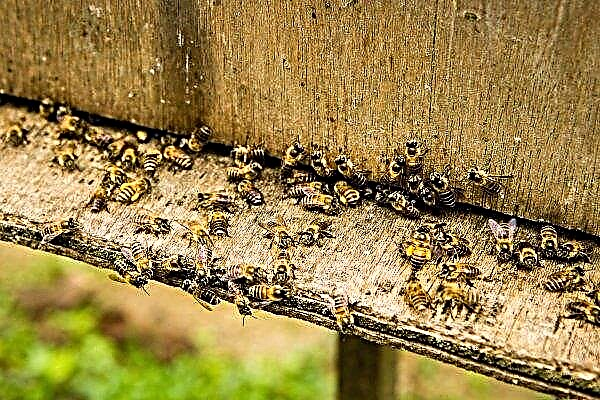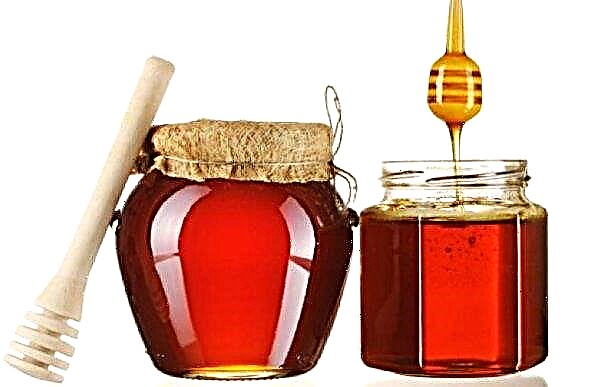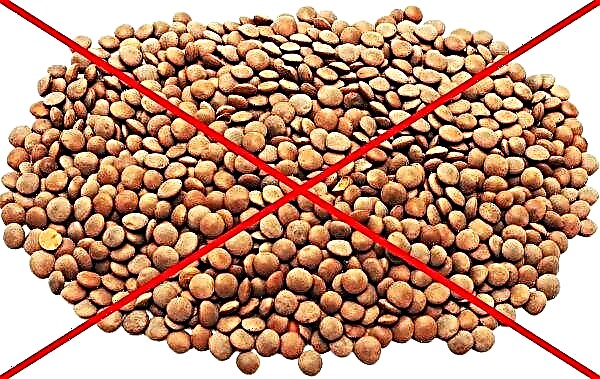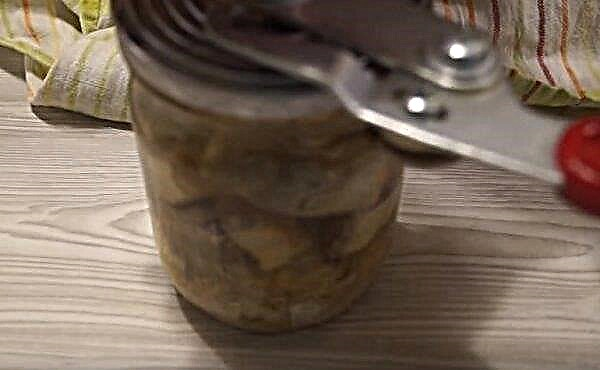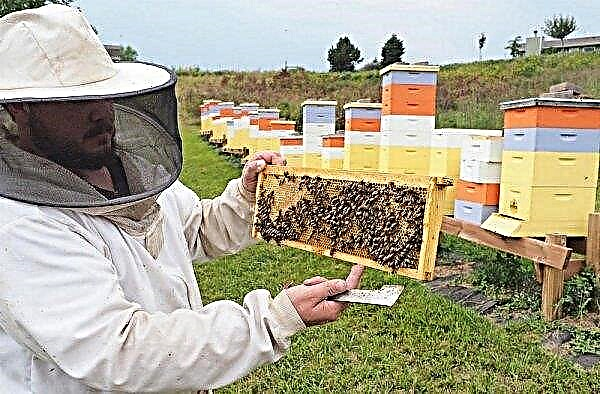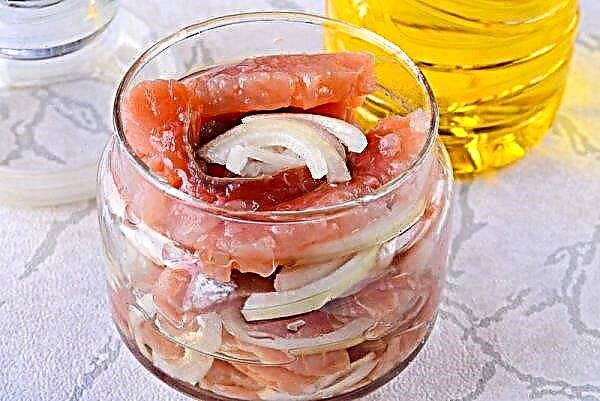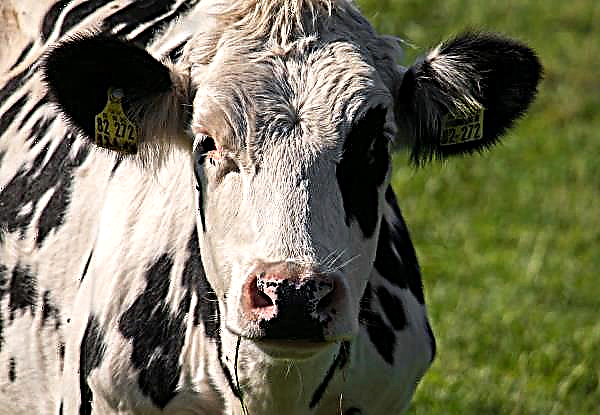Broilers, unlike other types of chickens, gain weight much faster, almost from the moment of birth. Some breeds of such birds are well suited not only for growing on an industrial scale, but also for households. The broiler ROSS-308 is precisely such a universal breed.
ROSS-308: breed description
All birds of this hybrid have white plumage, light skin and a scarlet comb. Like all broilers, the bird is quite large, for two and a half months the chicken adds up to three kilograms in weight. They were bred by the English company Ross, which for breeding took individuals from an adult population of chickens, the productivity of egg laying of which was 165–169 pieces per year, while their offspring should quickly gain weight and be highly survivable.
This hybrid is the result of a rather complex pattern of crossing five species of breeds in four generations. As a result, cross has the following performance indicators:
- at the age of 42 days, the weight of the bird is 2474 g;
- survival rate is 96%;
- every day the bird adds an average of 58 g.
This cross is no less productive in characteristics than KOBB-500, although it eats less feed and gives more meat, but ROSS-308 is still more versatile. Unlike relatives, the ratio between feed intake and weight gain is more rational. In addition, with regard to egg production, the ROSS-308 breed is still the leader, since COBB was bred as exclusively a meat breed that does not produce enough eggs. This breed is quite productive, because already at the age of one month the chicken meat acquires taste, and begins to rush quite early, without losing its qualities even in adulthood. The bird was bred for speedy weight gain, so you should pay special attention to these data. If the weight gain is less than 50-60 g per day, then such individuals are discarded. Details of bird growth are described in the weight gain table.
This breed is quite productive, because already at the age of one month the chicken meat acquires taste, and begins to rush quite early, without losing its qualities even in adulthood. The bird was bred for speedy weight gain, so you should pay special attention to these data. If the weight gain is less than 50-60 g per day, then such individuals are discarded. Details of bird growth are described in the weight gain table.
Weight gain by day looks like this:
| Days | Weight gain (in grams) |
| 0 | 40–45 |
| 1 | 50–60 |
| 2 | 65–80 |
| 3 | 85–95 |
| 4 | 100–115 |
| 5 | 120–135 |
| 6 | 140–165 |
| 7 | 170–190 |
| 8 | 200–220 |
| 9 | 230–250 |
| 10 | 260–280 |
| 11 | 300–325 |
| 12 | 345–370 |
| 13 | 380–420 |
| 14 | 440–460 |
| 15 | 485–520 |
| 16 | 540–565 |
| 17 | 580–630 |
| 18 | 650–690 |
| 19 | 720–750 |
| 20 | 780–820 |
| 21 | 850–890 |
| 22 | 920–970 |
| 23 | 1000–1030 |
| 24 | 1070–1100 |
| 25 | 1150–1200 |
| 26 | 1230–1270 |
| 27 | 1300–1350 |
| 28 | 1400–1450 |
| 29 | 1480–1500 |
| 30 | 1550–1580 |
Appearance
The appearance of this bird is characteristic of all broilers, so inexperienced poultry farmers often confuse them with other crosses. The body of this chicken is oval, stocky, has a wide and bulging chest, well muscled muscles. Paws ROSS-308 massive and spaced, have a bright color. Hips stand out strongly. This cross inherited structural features of the legs from fighting hens, for which a similar anatomy is necessary in their activities. Feather ROSS-308 pure white. If the bird has other colors in the color, this is a sign that the chicken needs to be rejected. The same applies to the color of the skin, which should be elastic and have a uniform tone for the attractiveness of the carcass. The head is disproportionately small in comparison with the body of the bird, on it is a leaf-shaped crest and scarce scarlet earrings.
Feather ROSS-308 pure white. If the bird has other colors in the color, this is a sign that the chicken needs to be rejected. The same applies to the color of the skin, which should be elastic and have a uniform tone for the attractiveness of the carcass. The head is disproportionately small in comparison with the body of the bird, on it is a leaf-shaped crest and scarce scarlet earrings.
| Part of the body | Appearance |
| Head | Small |
| Crest | Red, fleshy |
| Beak | Small neat |
| Neck | Short |
| Chest | Wide and powerful |
| Stomach | Bulging wide |
| Wings | Standard |
| Tail | Short |
| Paws | Massive, medium long |
| Plumage and color | Thick, even white |
Productive qualities
As already mentioned, ROSS-308 is a fairly productive cross, quickly gaining mass. So, with proper maintenance, after 12-14 weeks, the birds have a mass of 4-4.5 kg and are ready for slaughter.
Did you know? This bird will never lay an egg in a dark room, even when the time has come. In order to start the process of incubation, the bird needs light, and it does not matter whether it is natural or artificial.
These laying hens also have fairly early puberty, which increases their productivity in laying eggs. Despite the fact that this hybrid belongs to the category of meat, brood hens of this cross are not inferior to representatives of meat and egg type.
Temperament
Most broiler varieties are derived from fighting breeds of chickens. But the years of selection have led to the eradication of traits specific to fighters, such as aggressiveness and conflict. The same applies to the broiler ROSS-308. Chickens and adult birds behave quite calmly and peacefully. They do not attack other hens and get along well with other species of birds. In addition, this cross gets used to various forms of content without problems and is able to inhabit cells. But you should not experiment with this, since the restriction in movement negatively affects the taste of the meat.
They do not attack other hens and get along well with other species of birds. In addition, this cross gets used to various forms of content without problems and is able to inhabit cells. But you should not experiment with this, since the restriction in movement negatively affects the taste of the meat.
Advantages and disadvantages
- The main advantages of this cross are:
- Benefit. This hybrid is very beneficial in content because it grows quickly and adds weight, while consuming a moderate amount of feed.
- Environmental friendliness. Despite the fact that many people consider this meat to be oversaturated with hormones due to the rapid growth of poultry, this is not so. Breeders have worked on chicken meatiness for more than a hundred years and have achieved a natural increase in weight without loss of product quality.
- High egg production. Of course, these chickens can not be compared with egg-type layers, but as for meat cross-country, they show rather good results.
- Good immunity. Birds have a high survival rate and are resistant to various diseases.
- Of the weakest features, poultry farmers distinguish the following:
- Heavy breeding. ROSS-308 is almost impossible to breed at home, therefore, to increase the number of livestock, it is necessary to purchase incubation material each time.
- Power control. Due to the rapid growth of poultry, you need to carefully monitor the amount of food in the feeders and that the diet is completely balanced, with a sufficient amount of essential trace elements and vitamins.
Growing broiler ROSS-308
After buying chickens, it is recommended to immediately settle on the farm. Young growth is placed in brooders in which birds live for about 10 days. For comfortable maintenance, it is recommended to maintain a temperature of +30 ... + 32 ° C. Young crosses in the first four weeks of life require special attention. At this time, it is very important to maintain the correct thermal mode, which should not exceed +32 ° C, gradually lowering the thermometer by one degree until the room temperature reaches +20 ° C.
A special mode of humidification should be observed. The first 10 days, the humidity should be at least 65%, and after this period at least 55%. Lighting also plays an important role - it must be turned off for an hour every 22 hours, gradually reducing the illumination to 13 hours. You also need to constantly monitor the cleanliness in the chicken coop and wash the feeders in time, in which there should always be enough food.
Video: broiler growing ROSS 308
On the litter
If you decide to grow a broiler on a litter, you must remember that young cross requires high-quality litter, because due to poor material the bird will be very susceptible to disease, and therefore all young growth can be lost. The litter should be hygroscopic and loose, and also have the ability to absorb unsafe gases. In addition, care must be taken to ensure that the litter is always dry. As for air, it should be clean and humidity should be between 60–65%.
If these indicators are exceeded, then the body of chickens can weaken and become susceptible to disease, otherwise, that is, when the air dries up, respiratory diseases can occur. These indicators are regulated by ventilation and the correct choice of litter. The best solution is to use well-dried coniferous sawdust as a bedding. But you can choose sphagnum peat or a pocket of sunflower, which will be a good substitute for sawdust.
Important! For the safe growth of a young livestock, it must be provided with a sufficient amount of oxygen, since broilers breathe a lot of steam and carbon dioxide when breathing.
The bedding layer should be at least 7 centimeters. It is recommended to maintain the temperature regime when keeping on litter with the help of electric heaters. 50-60 centimeters from them place a plywood or fabric fence, the height of which should be about 40 centimeters. The room warms up to 26 degrees a couple of days before the appearance of chickens. It takes no more than an hour to cross-country at one day old, but by twenty days the sleep period is increased to 9 hours. From this moment it is again reduced, gradually leaving the chicken to rest for 4 hours. Regarding this mode, the duration of daylight hours is also regulated. This method of keeping is good in that it is very comfortable for birds and easy to care for, so litter is often used for home rearing.
From this moment it is again reduced, gradually leaving the chicken to rest for 4 hours. Regarding this mode, the duration of daylight hours is also regulated. This method of keeping is good in that it is very comfortable for birds and easy to care for, so litter is often used for home rearing.
On mesh floors
Breeding of chickens on mesh floors is mainly used in large-scale production. This method is very economical, because the litter is not required, the purity in the pen is preserved. The cells should have such a perimeter so that the paws of the chickens do not fall there, and the litter easily passed to the pallet. Young animals in this type of housing are placed under brooders with a population density of eight-month-old chickens - from 25 to 35 birds per square meter. The first days, paper is placed under the brooders, and the chickens themselves are kept behind the screens, which are removed after 10 days.
Important! Humidity and temperature should also be regulated depending on the time of year, since the heat is felt more at high humidity, which means that it is worth reducing the percentage of moisture.
For newly born crosses, chicken coop lighting should last at least 23 hours in the amount of 40 Luxes, this period over time is reduced to 18 and the amount of light also (up to 15 Luxes). The temperature for different age chickens is also different. So, for the smallest, it should not exceed +28 ° С and be lower than + 26 ° С. With the growth of young animals, it gradually decreases to +10 ... + 12 ° С. No less closely should be monitored for air humidity, which should be from 55 to 70%. If the density of the chickens is high, then the chicken coop must be equipped with a good ventilation system.
In the cells
You can achieve rapid chicken growth by limiting its mobility by populating the bird in a cage. At the same time, the place in the chicken coop is also saved, since such houses for chickens are placed in several tiers. In order for the chickens to move easily, the first days the floor is covered with thick paper. In the case of raising chickens in cages, it is necessary to ensure a temperature regime at which initially the air in the room needs to be warmed up to +30 degrees, gradually lowering this indicator to +18 ° C.
The same applies to humidity, which should not exceed 70% and be below 50%, since these indicators directly affect the state of the respiratory system of the cross. For daily babies, as with other methods of detention, they are supposed to give 23 hours of light, and already from the seventh day this period decreases to 17-23 hours.
The duration of daylight hours depends on the amount of food consumed and weight gain, but when keeping broiler breeds, they do not save on this. This type of cultivation involves the initial calibration of eggs and sorting of young animals by gender. It is also important to select defective chickens.
Video: the content of broilers ROSS-308 in cells
Feeding
Manufacturers recommend feeding ROSS-308 special feeds, but you can replace them with home ones, provided that they are of the highest quality. This is especially true for young animals, because while the chickens are still very small, the feed is the makings for their further growth. It is also important that birds have free access to water and food. The feeder can be both floor and hanging. It should be made in such a way that the bird could not climb into it with its paws, otherwise the chickens will litter the feed, and the volume of the feeder should be enough to fill the container with the daily food norm for the whole livestock.
Another important aspect is the availability of the feeder - it should be located so that all birds can easily get to the food. A broiler drinker should be convenient not only for chickens, but also for poultry farmers. It is necessary that its filling be easy, and preferably automatic from a crane, and the material from which it is made meet the strength requirements and endure feathered attacks, because damaged containers will become a source of excess dampness. In addition, the drinker should not be oxidized when interacting with some preparations for chickens, for this reason it is better to choose a container from durable plastic. The water in the drinker should be clean and fresh. It is necessary to ensure that it does not bloom. To do this, it is best to use closed drinking bowls so that they do not get dirt.
In addition, the drinker should not be oxidized when interacting with some preparations for chickens, for this reason it is better to choose a container from durable plastic. The water in the drinker should be clean and fresh. It is necessary to ensure that it does not bloom. To do this, it is best to use closed drinking bowls so that they do not get dirt.
Chickens
The first days of feeding are very important and at the same time dangerous, because you need to carefully select a diet for birds. Juicy or wet foods should not be given to chickens, as they can be an excellent breeding ground for bacteria. Features of feeding are as follows:
- Chickens up to 5 days can be fed small oatmeal or millet. It is sometimes permitted to give freshly boiled eggs.
- By the age of three days, chicks can already be given fresh chopped greens, which must first be thoroughly washed. In addition, curd and sprouted barley can be added to the feed. It is also necessary to add vitamins and minerals.
- Vegetables are allowed to be given from the 10th day of life. Carrots and potatoes are good, as they contain a large amount of carbohydrates and minerals. In addition, these vegetables do not lose their properties even after cooking.
- Special mixtures for broiler feeding are required from the 15th day of life. It is during this period that an active set of muscle mass begins, so birds need a nutritious diet. These special feeds contain all the substances that are necessary for rapid growth. Homemade grain mixes are made with strict observance of a combination of substances, observing a percentage ratio. Any deviations affect the rate of weight gain.
A feature of broilers is that, quickly gaining weight, they need enough vitamins and minerals. All these features are taken into account in specialized feeds. For those who eat homemade mixtures, it is necessary to introduce additional substances into the diet. On average, about 1.7–1.9 kg of feed is consumed per kilogram of bird weight.

Adults
The diet of adults ROSS-308 is quite different from the nutrition of babies. Here, ready-made feeds will also come to the rescue, but only for adults, which include the elements necessary for providing the chicken body with important substances for laying eggs and improving the quality and taste of meat. Such feeds require approximately 150 g per day for one layer. But store mixes for these birds can also be replaced with home ones.
Grain mixtures should include as many proteins as possible, and 10% should be fats and carbohydrates. Particular advantage should be given to barley, corn, oats and wheat. Adults will not be given more than wet mixtures, which will enrich the body with useful substances. You can also steal crushed grains with strong meat broth, where minerals, vegetables, and trimmings from fish or meat are added for greater benefit. But it is worth remembering that all the additives are put into the already cooled porridge, otherwise they will lose their properties. Adult broilers are usually fed at least three times a day. In the warm season, crosses are able to search for an herbal snack for themselves, but this should not be a prerequisite for stopping the main feeding.
But it is worth remembering that all the additives are put into the already cooled porridge, otherwise they will lose their properties. Adult broilers are usually fed at least three times a day. In the warm season, crosses are able to search for an herbal snack for themselves, but this should not be a prerequisite for stopping the main feeding.
Incubation mode
You need to buy hatching eggs very carefully, carefully choosing the same size, without marriage and damage, they must also have the correct shape. In addition, the ROSS-308 seal must be on the eggs, and the seller must have a certificate of authenticity of the incubation material. After the eggs are bought, they will need to be heated naturally, while the air temperature should be warmed up to 25 degrees.
Did you know? Hatching material broiler ROSS-308 has a fairly low price, acceptable even for the most economical farmers. It is considered one of the cheapest materials among all meat breeds.
Then follows the output mode, which is the same as for ordinary chickens. The temperature for the eggs in the incubator is set at 38 degrees Celsius. The first seven days it should be 37.9 ° C, after which it decreases by a degree and keeps at this level for the next week. Already on the 18th day, the temperature was lowered to 36.5 ° C, and to the conclusion itself - 36.2 degrees Celsius. During the incubation period, experienced breeders advise setting a high humidity regime for birds ROSS-308, which is recommended to be maintained at a level of at least 80% until the moment of withdrawal. This is done so that the shell does not dry out and does not become too hard, otherwise the chickens will not be able to hatch on their own.
During the incubation period, experienced breeders advise setting a high humidity regime for birds ROSS-308, which is recommended to be maintained at a level of at least 80% until the moment of withdrawal. This is done so that the shell does not dry out and does not become too hard, otherwise the chickens will not be able to hatch on their own.
Diseases of birds and their treatment
All chicken diseases are very unprofitable both for industrialists and for owners of small households. At the same time, it is young individuals that are most susceptible to ailments. It is important to distinguish between bird diseases by symptoms in order to identify the disease in time and take measures. The most common ailments of ROSS-308 are as follows:
- Bronchopneumonia - This is a non-communicable disease that develops as a result of freezing of a bird (for example, if it has been exposed to rain) or infection. This disease is characterized by lethargy, wheezing, nasal discharge, and loss of appetite. This disease is usually treated with antibiotic drugs (Penicillin, Terramycin, Norfloxacin), otherwise chickens can die in a couple of days.
- Newcastle disease - This is an infection that leads to pneumonia, encephalitis and can cause hemorrhages in various organs of the bird. Chickens with this disease behave sluggishly, practically do not eat. In birds, the temperature rises strongly, which can reach 44 degrees, and the coordination of movements is disturbed. Conjunctivitis, coughing, coughing, spotting, and diarrhea are also characteristic symptoms. This disease is incurable, and death from it occurs within a few hours.
- Mycoplasmosis Is an infectious disease that affects the respiratory organs and causes shortness of breath, lethargy, wheezing and swelling of the eyelids. 5-10% of the chickens from the population die, but in general the disease is treatable. To do this, use drugs such as Tilosin, Tiamulin or Enrofloxacin.
- Marek's disease - An infection that affects the nervous system of a bird and leads to paralysis of various parts of the body. This disease is not subject to treatment.
- Salmonellosis - This is an infectious disease in which the bird begins diarrhea, weakness, drowsiness, inflammation of the cloaca, swelling of the legs, inflammation of the eyelids. Also, this infection greatly affects the development of the feathered and its growth. Small chickens are most susceptible to this disease, about a third of them may die. Adult hens can be carriers of this disease and get sick in a chronic form. Furazolidone and streptomycin are recommended to treat infection.
- Typhoid Chicken Is an infectious disease that affects the intestines. With it, the temperature rises to 44 degrees, there is whitish or greenish diarrhea, a blue appears on the crest and mucous membranes. The disease itself is very dangerous, therefore, requires immediate treatment with antibiotics, such as sulfadimezin.
- Coccidiosis Is a disease caused by parasites. This is usually a chronic disease that leads to chick lethargy, diarrhea, and mucus secretion. Birds quickly lose weight, their limbs can be paralyzed, so it is important to stop the development of parasites with the following drugs: Statil, Zoalen, Koktsidin, Dekoks, Amprolium, Sakoks, Baykoks.
- Bird flu - in acute form, the coordination of movements, inhibition of reflexes, a significant increase in temperature are disturbed in birds. But there is also a mild form of the course of the disease, when the state of plumage is disturbed in birds. This disease cannot be treated.
- Chicken pox - a viral disease that is not treated. In chickens, conjunctivitis is observed, edema, mucus, pus and smallpox appear on the eyes. Birds stop eating, become lethargic, plumage is disturbed. Mortality is up to 70% of individuals in a population.
 In general, the cultivation of this cross is quite cost-effective, since it is unpretentious in content, but it is quite productive not only in terms of meat, but also eggs. In addition, this broiler is hardy and disease resistant. In order to get good profit from growing these chickens and not spend extra resources, it is enough to just monitor the conditions of broiler keeping, and especially the cleanliness of the chicken coop and diet.
In general, the cultivation of this cross is quite cost-effective, since it is unpretentious in content, but it is quite productive not only in terms of meat, but also eggs. In addition, this broiler is hardy and disease resistant. In order to get good profit from growing these chickens and not spend extra resources, it is enough to just monitor the conditions of broiler keeping, and especially the cleanliness of the chicken coop and diet.

